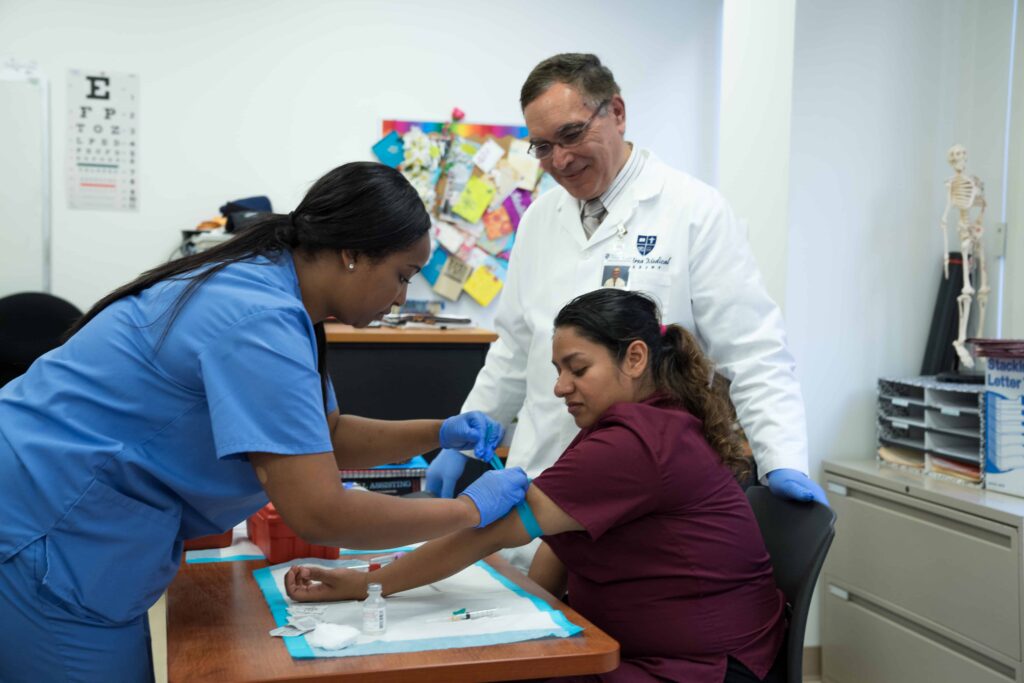Class Calendar | Call admissions on 415-943-2028
Get free phlebotomy training—exclusively for eligible Amazon Associates / Find MA training at BAMA
Class Calendar | Call admissions on 415-943-2028

Suppose you are interested in healthcare or have recently had your blood drawn. Maybe you have seen or heard both phrases and were curious about the distinction. You might wonder: what is the difference between a phlebotomist and a phlebotomy technician?
Surprisingly enough, there is actually no difference between a phlebotomist and a phlebotomy technician! Both are terms for the same certified healthcare professional – someone who draws blood for analysis. Confusing, right?
A phlebotomist, or phlebotomy technician, is a specialized healthcare professional who collects blood samples from patients. Below is a breakdown of their responsibilities.
| Phlebotomist Responsibilities | |
| Patient Preparation | Explain the procedure to the patientHelp the patient relax and feel calmIdentify the best vein or capillary for collectionGet the patient in the correct position for blood collection |
| Infection Control | Wear proper personal protective equipmentMasks, gloves, eye protection, gownsSterilize equipmentPrevent sample contaminationPrevent the spread of germs |
| Venipuncture | What you probably think of when you hear “blood draw”Blood collection from a veinUses a needle, syringe, and collection tubes (vials) |
| Capillary Puncture | Blood collection through smaller capillaries (fingertip)Common for blood glucose monitoring |
| Record Keeping | Proper record-keeping, including accurately labeling the samples |
| Sample Handling | Safely pack and transport samples to the lab for analysis |
| Communication | Communicate with medical staff about patient collection needsCommunicate with the patient about the procedureSpecific instructions like fasting or pausing medicationsAnswer questionsCommunicate with the lab when you transport samples for testing |
| Lab Management | Prepare samples for testingMaintain equipmentManage lab records |
There are many settings where a phlebotomist might work, including:
Some hospitals or clinics will distinguish between phlebotomists based on years of experience and training, creating a new title to tell the roles apart. In those settings, different “phlebotomist technician levels” might be allowed to perform other tasks or have additional duties. However, these phlebotomists will still all have the same education and training needed to be certified professionals in California.
The first step to becoming a phlebotomist is getting the best education in your field. Phlebotomy education focuses on learning the skills needed for safe blood collection.
All certified phlebotomists in California must pass a certification exam, and having a great education from an accredited institute will set you up for success on this exam!
Educational requirements for California phlebotomy certification differ depending on your work background and experience. At a minimum, all phlebotomists will need:
The best programs will incorporate these requirements into structured classroom education, clinical training, and an externship to tie everything together.
After you get your education and training, you will need to pass an exam for certification and apply for your license. The NCPT is a national exam for phlebotomists, and the CPT-I is a specific license required to practice phlebotomy in California. After you pass your exam and have your CPT-I license, you will complete your phlebotomy education with an externship to gain valuable clinical practice and begin networking to find a job after graduation.
Once you have completed your phlebotomy training at an institute accredited by the California Department of Public Health and passed the NCPT exam, you can apply for your CPT-I license.
The best way to prepare for a career in phlebotomy is to get your CPT-I license. To do that, you need to pass the NCPT exam and complete thorough training at a reputable phlebotomy training program. The BAMA Institute is the premier training institute for phlebotomists in California. BAMA Institute has a comprehensive program to help you learn the skills and techniques necessary to become a certified phlebotomist.
Are You Ready to Explore a Career in Phlebotomy? Now that you know there isn’t a difference between a phlebotomist and a phlebotomy technician, Reach out to the BAMA Institute to learn more about becoming one.
"*" indicates required fields
© 2024 BAMA Institute. All Rights Reserved. Website by WindsAndWater